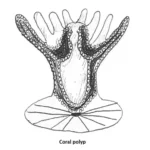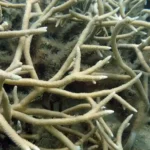Staghorn Corals on Guam
Table of Contents
Share This
Corals and their relatives
When people think of corals, usually the first thing they picture is not an actual coral, but a coral reef: large calcium carbonate (limestone) structures, filled with colorful plants and animals. Corals themselves are only one part of coral reefs (albeit a very important one) and while they secrete the material that makes up the reefs (calcium carbonate), they are, in fact, animals. Corals are relatives of jellyfish and anemones. While at first glance they may look nothing like their relatives, if you take a closer look you start to see some similarities.
If you look closely at the coral you will notice tiny hair-like protrusions sticking out from the sides. These are the coral’s tentacles and the things they are protruding from are polyps. Polyps are similar to a jellyfish medusa. In fact, if you flip them around they look almost identical.
Like jellyfish, corals are carnivores. Both animals have nematocysts (stinging cells) in their tentacles that aid in the capture of prey. However, corals do not depend completely on catching prey for food. They also have tiny algae called zooxanthellae living inside them. Zooxanthellae transfer 20 to 95 present of the food they make from photosynthesis to corals, and give corals their distinctive color. When a coral is stressed, zooxanthellae are expelled, a process known as “coral bleaching.” When the zooxanthellae leaves, the coral loses its color and turns white, which is why we call it coral bleaching. This can be fatal for the coral as this drastically lowers its supply of food, however if the stressor is removed, the coral can survive and reuptake zooxanthellae.
Staghorns
Staghorn corals belong to the genus (a taxonomic category above species) Acropora. The name is a combination of the Greek word akron meaning summit and Latin word porous in reference to the polyp at the tip of each branch. Staghorns’ (named because they look like deer antlers) long branches create unique three-dimensional structures, which provide important refuge spaces for many reef fish and other animals. This type of shelter is so important that the existence of staghorn corals on a reef can increase fish diversity and abundance.
Staghorns are also important reef builders. To give an idea of the extent of the staghorns’ importance to reefs, the loss of staghorn corals can cut the amount of carbonate (limestone) produced on a reef by half. This is important for human coastal communities as well, as reefs dissipate up to 97 percent of wave energy, making them an important coastal protector, especially during storms.
Compared to the Caribbean, the Pacific has a much higher abundance and diversity of Acropora species (including staghorns). For example, while the Caribbean only has two different types of staghorns, Guam has at least five different species.
Many staghorns in the Caribbean have recently died. In the early 1980s, their populations declined by over 90 percent and the downward trend has continued since then. Disease, abnormally warm temperatures, and physical damage from hurricanes are the major causes of this massive decline. The staghorns in the Pacific are by no means safe from a similar fate.
Guam experienced two island-wide bleaching events in the summers of 2013 and 2014 because of high temperatures, as well as high mortality from extreme low tides starting in 2014 to the end of 2015. The total mortality for our staghorn populations was approximately 50 percent after these three years.
Not all hope is lost
Researchers are investigating why some corals survived and others died during the two major bleaching events. Scientists from the University of Guam are also studying their reproductive behavior, how fast they can grow, and are using genetics to understand responses to stressors inside their tissues. They have also begun a coral nursery where the corals grow in sheltered conditions until they get larger and will be planted back onto the reefs in places that are safer for them.
About the author

James Fifer was a graduate student at the University of Guam Marine Lab. He graduated in 2018. His thesis was “Examining Gene Expression of Heat-stressed Staghorn Coral Under Different Flow Environments.”
Editor’s note: This author was a beginning graduate student in 2017 taking a course in scientific writing at the University of Guam. This article was assigned to provide the student with practice in communicating science to non-scientists. The student chose the topic which is related either to their thesis project or work experience. The instructor in the course is Dr. Laurie Raymundo, a UOG Marine Laboratory faculty member.
For further reading
Burdick, David. “Guam Reef Life Home Page.” Guam Reef Life, 2017.
Raymundo, Laurie, David Burdick, Valeri Lapacek, and Roxanna Miller. “Anomalous Temperatures and Extreme Tides: Guam Staghorn Acropora Succumb to a Double Threat.” Marine Ecology Progress Series 564, (2017): 47-55.
US Department of Commerce National Oceanic and Atmospheric Administration National Marine Fisheries Service. Atlantic Acropora Status Review. By Rafe Boulon, Mark Chiappone, Robert Halley, Walt Jaap, Brian Keller, Bill Kruczynski, Margaret Miller, and Caroline Rogers. Florida: SRO, 2005.











